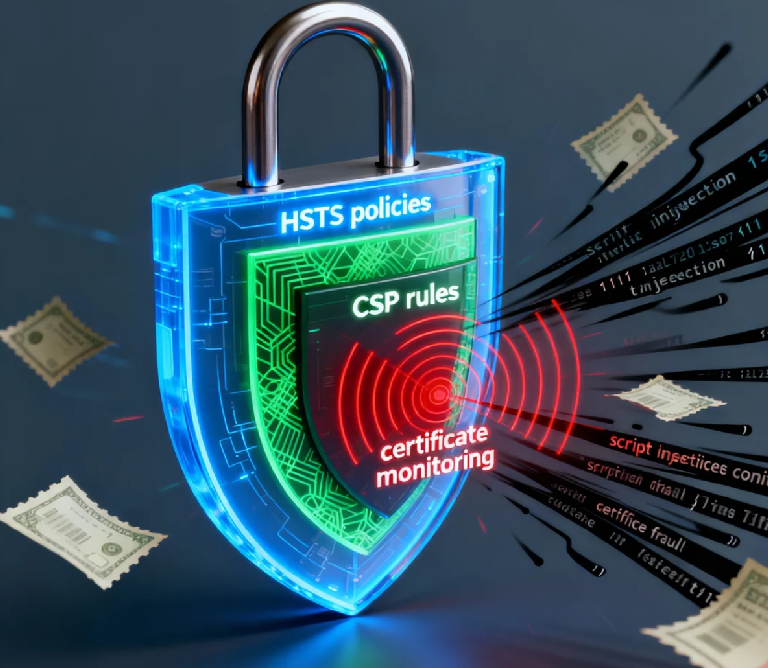Beyond the Padlock: 5 Advanced HTTPS Configurations to Outsmart Modern Threats

That little padlock in your browser bar - it's comforting, isn't it? Like a sturdy deadbolt on your front door. But here's the uncomfortable truth: modern cyber threats aren't trying to pick your lock anymore. They're climbing through open windows you didn't know existed, or simply walking through walls because your security thinks they're invited guests.
I've seen too many organizations treat HTTPS as a checkbox item. "Get certificate, install it, see the padlock - done." But in reality, that basic setup is like installing a high-tech lock while leaving your house keys under the doormat. The threat landscape has evolved, and your HTTPS configuration needs to evolve faster.
Let me show you five advanced configurations that will transform your HTTPS from basic protection to active defense.
1. Implement Strict Transport Security with Maximum Age
Think of HTTP as sending postcards - anyone along the delivery route can read them. HTTPS is your sealed envelope. But what stops someone from intercepting the initial request and forcing it back to HTTP? That's where HSTS comes in.
When you implement HSTS with a long max-age, you're essentially telling browsers: "For the next year, only communicate with me through encrypted channels. Don't even try HTTP." It's like installing a one-way valve on your security - traffic only flows through HTTPS.
But don't just set it and forget it. Start with a short max-age (like 300 seconds) to test compatibility. Then gradually increase it. I recommend at least 31536000 seconds (one year) for production sites. And remember to include your subdomains in the policy - attackers love targeting weaker subdomains as entry points.
2. Deploy Content Security Policy as Your Web Bodyguard
Imagine your website is a VIP at a crowded event. CSP is your professional security detail that only allows approved individuals to approach. Even if an attacker manages to inject malicious scripts into your site, CSP prevents those scripts from executing.
The magic happens through whitelisting. You specify exactly which domains are allowed to load content, run scripts, or make connections. I've seen CSP block credit card skimmers that other security measures missed because the malicious scripts came from unauthorized domains.
Start with report-only mode to catch false positives, then gradually enforce the policy. Your CSP should be like a careful bouncer - strict enough to keep trouble out, but smart enough to recognize legitimate guests.
3. Master Certificate Transparency Monitoring
Here's a scary scenario: someone obtains a fraudulent SSL certificate for your domain. Until recently, you might not discover this until customers reported strange security warnings. Certificate Transparency changes this by creating public logs of all issued certificates.
By monitoring these logs, you get instant alerts when new certificates are issued for your domains. It's like having someone watch every locksmith in the world and notify you whenever a new key is made for your house.
Set up monitoring through services like Google's Certificate Transparency Report or third-party security platforms. The few minutes it takes to configure could save you from a devastating brand impersonation attack.
4. Configure Modern Cipher Suites for Optimal Performance
Not all encryption is created equal. Some cipher suites are like armored trucks - incredibly secure but slow and resource-heavy. Others are like sports cars - fast but less protective. The right cipher suite balances both.
Focus on suites that support forward secrecy and use modern algorithms like AES-GCM and CHACHA20. These not only provide strong security but also leverage hardware acceleration for better performance. It's like having a security system that actually makes your house more efficient to live in.
Regularly audit your cipher suite configuration and disable weak protocols like TLS 1.0 and 1.1. Your goal is to create a cryptographic handshake that's both secure against quantum computing threats and optimized for real-world performance.
5. Implement OCSP Stapling for Privacy and Speed
Every time someone visits your site, their browser could be checking with a third party to verify your certificate hasn't been revoked. This creates privacy leaks and slows down connections. OCSP stapling solves both problems.
With OCSP stapling, your server periodically gets a timestamped validation receipt from the certificate authority. When visitors connect, you provide this receipt instead of forcing their browser to make external verification calls. It's like carrying your verified ID instead of making everyone call the DMV to check your credentials.
The performance improvement is noticeable, especially for mobile users with higher latency. Plus, you're not leaking visitor information through external OCSP requests.
These configurations transform your HTTPS from basic protection to intelligent defense. They work together like a security ecosystem rather than isolated features. The padlock becomes not just a symbol of encryption, but of comprehensive protection.
The best part? Most of these configurations require minimal ongoing maintenance once implemented. They're the kind of "set and properly forget" security upgrades that separate professional setups from amateur ones.
Your HTTPS should be a dynamic, evolving defense system - not a static trophy of compliance. Because in the world of web security, standing still is the most dangerous position of all.

